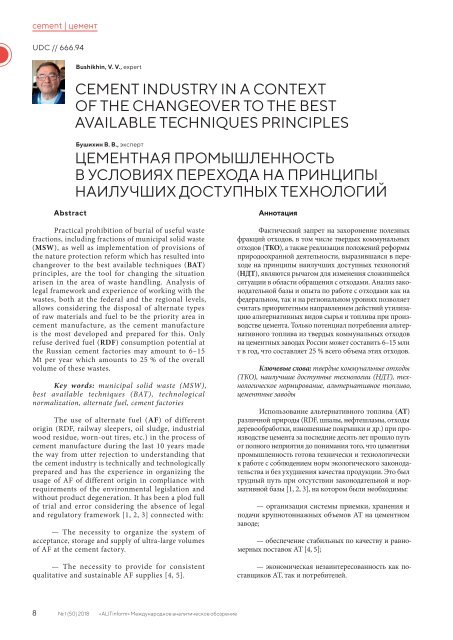AlitInform 50
“ALITinform” is a periodical that covers different aspects in production and applications of cement, concrete, and dry building mixtures. Pages of this journal offer contributions from leading Russian and International scientists, technologists and leading professionals, news from the stock markets, research laboratories, latest elaborations by producers and suppliers of modern building materials and equipment. The magazine goal is to unite on its pages the articles of the leading Russian and International specialists in the field of cement, concrete, dry building mixtures; latest news of the Russian and world building materials market, the traditions of peer-reviewed Russian scientific magazines and innovative informational approach of the contemporary printed media. The prime focus is on developments serving the purpose of rationalization of production, reduction of energy consumption, enhancement of quality and improvement of environmental safety. _______________________________________
“ALITinform” is a periodical that covers different aspects in production and applications of cement, concrete, and dry building mixtures. Pages of this journal offer contributions from leading Russian and International scientists, technologists and leading professionals, news from the stock markets, research laboratories, latest elaborations by producers and suppliers of modern building materials and equipment.
The magazine goal is to unite on its pages the articles of the leading Russian and International specialists in the field of cement, concrete, dry building mixtures; latest news of the Russian and world building materials market, the traditions of peer-reviewed Russian scientific magazines and innovative informational approach of the contemporary printed media. The prime focus is on developments serving the purpose of rationalization of production, reduction of energy consumption, enhancement of quality and improvement of environmental safety.
_______________________________________
Create successful ePaper yourself
Turn your PDF publications into a flip-book with our unique Google optimized e-Paper software.
cement | цемент<br />
UDC // 666.94<br />
Bushikhin, V. V., expert<br />
CEMENT INDUSTRY IN A CONTEXT<br />
OF THE CHANGEOVER TO THE BEST<br />
AVAILABLE TECHNIQUES PRINCIPLES<br />
Бушихин В. В., эксперт<br />
ЦЕМЕНТНАЯ ПРОМЫШЛЕННОСТЬ<br />
В УСЛОВИЯХ ПЕРЕХОДА НА ПРИНЦИПЫ<br />
НАИЛУЧШИХ ДОСТУПНЫХ ТЕХНОЛОГИЙ<br />
Abstract<br />
Practical prohibition of burial of useful waste<br />
fractions, including fractions of municipal solid waste<br />
(MSW), as well as implementation of provisions of<br />
the nature protection reform which has resulted into<br />
changeover to the best available techniques (BAT)<br />
principles, are the tool for changing the situation<br />
arisen in the area of waste handling. Analysis of<br />
legal framework and experience of working with the<br />
wastes, both at the federal and the regional levels,<br />
allows considering the disposal of alternate types<br />
of raw materials and fuel to be the priority area in<br />
cement manufacture, as the cement manufacture<br />
is the most developed and prepared for this. Only<br />
refuse derived fuel (RDF) consumption potential at<br />
the Russian cement factories may amount to 6–15<br />
Mt per year which amounts to 25 % of the overall<br />
volume of these wastes.<br />
Key words: municipal solid waste (MSW),<br />
best available techniques (BAT), technological<br />
normalization, alternate fuel, cement factories<br />
The use of alternate fuel (AF) of different<br />
origin (RDF, railway sleepers, oil sludge, industrial<br />
wood residue, worn-out tires, etc.) in the process of<br />
cement manufacture during the last 10 years made<br />
the way from utter rejection to understanding that<br />
the cement industry is technically and technologically<br />
prepared and has the experience in organizing the<br />
usage of AF of different origin in compliance with<br />
requirements of the environmental legislation and<br />
without product degeneration. It has been a plod full<br />
of trial and error considering the absence of legal<br />
and regulatory framework [1, 2, 3] connected with:<br />
— The necessity to organize the system of<br />
acceptance, storage and supply of ultra-large volumes<br />
of AF at the cement factory.<br />
— The necessity to provide for consistent<br />
qualitative and sustainable AF supplies [4, 5].<br />
Аннотация<br />
Фактический запрет на захоронение полезных<br />
фракций отходов, в том числе твердых коммунальных<br />
отходов (ТКО), а также реализация положений реформы<br />
природоохранной деятельности, выразившаяся в переходе<br />
на принципы наилучших доступных технологий<br />
(НДТ), являются рычагом для изменения сложившейся<br />
ситуации в области обращения с отходами. Анализ законодательной<br />
базы и опыта по работе с отходами как на<br />
федеральном, так и на региональном уровнях позволяет<br />
считать приоритетным направлением действий утилизацию<br />
альтернативных видов сырья и топлива при производстве<br />
цемента. Только потенциал потребления альтернативного<br />
топлива из твердых коммунальных отходов<br />
на цементных заводах России может составить 6–15 млн<br />
т в год, что составляет 25 % всего объема этих отходов.<br />
Ключевые слова: твердые коммунальные отходы<br />
(ТКО), наилучшие доступные технологии (НДТ), технологическое<br />
нормирование, альтернативное топливо,<br />
цементные заводы<br />
Использование альтернативного топлива (АТ)<br />
различной природы (RDF, шпалы, нефтешламы, отходы<br />
деревообработки, изношенные покрышки и др.) при производстве<br />
цемента за последние десять лет прошло путь<br />
от полного неприятия до понимания того, что цементная<br />
промышленность готова технически и технологически<br />
к работе с соблюдением норм экологического законодательства<br />
и без ухудшения качества продукции. Это был<br />
трудный путь при отсутствии законодательной и нормативной<br />
базы [1, 2, 3], на котором были необходимы:<br />
— организация системы приемки, хранения и<br />
подачи крупнотоннажных объемов АТ на цементном<br />
заводе;<br />
— обеспечение стабильных по качеству и равномерных<br />
поставок АТ [4, 5];<br />
— экономическая незаинтересованность как поставщиков<br />
АТ, так и потребителей.<br />
8 № 1 (<strong>50</strong>) 2018 «ALITinform» Международное аналитическое обозрение



